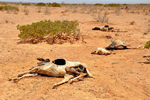Despite outsized media and political attention to climate change deniers, climate scientists long ago reached a consensus that not only is climate change occurring, but it’s largely due to human actions. A new study in Environmental Research Letters further strengthens this consensus: looking at 4,000 peer-reviewed papers researchers found that 97 percent of them supported anthropogenic (i.e. human caused) global warming. Climate change denialists, many of them linked to fossil fuel industries, have tried for years—and often successfully—to undercut action on mitigating climate change through carefully crafted misinformation campaigns.
“Our findings prove that there is a strong scientific agreement about the cause of climate change, despite public perceptions to the contrary,” lead author John Cook with the University of Queensland said. “There is a gaping chasm between the actual consensus and the public perception. It’s staggering given the evidence for consensus that less than half of the general public think scientists agree that humans are causing global warming.”
Focusing on peer-reviewed papers covering climate science, the researchers tackled a massive sampling of research, wading through 11,994 papers by nearly 30,000 scientists over the last 20 years. Around one third (4,000) of these staked out a position on anthropogenic global warming. Of those that stated a position, 97.1 percent favored human caused climate change, while only 2 percent (87 papers) actually disputed human-caused climate change.
In addressing the fact that two thirds of papers expressed no opinion, the study’s authors write, “Of note is the large proportion of abstracts that state no position on anthropogenic global warming. This result is expected in consensus situations where scientists ‘. . . generally focus their discussions on questions that are still disputed or unanswered rather than on matters about which everyone agrees’ (Oreskes 2007, p 72).”
This is similar to the fact that most biology papers don’t stake out a stance on evolution, but take it as a given.
The climate study isn’t surprising, as past research has come away with similar findings: a study in 2010 questioned nearly 1,000 scientists and found that 97.5 percent agreed that climate change is being caused by human activities. Although the two studies used hugely different methodologies, it’s notable that their findings came away with almost exactly the same percentages that accept human-caused climate change.
Global climate change has risen temperatures by approximately 0.8 degrees Celsius (1.4 degrees Fahrenheit) since the beginning of the Industrial Revolution due to greenhouse gas emissions. Hotter temperatures have led to rising sea levels, melting glaciers, vanishing Arctic sea ice, wildlife migrations, and more extreme weather among other impacts. In fact, greenhouse gas emissions have also led to ocean acidification which is imperiling many marine species, including the world’s coral reefs. Recent research has also found that climate change may be shifting the jet stream, leading to extreme weather and unseasonable temperatures (both warm and cold) in the northern hemisphere.
Despite the science, nations have been slow to react and greenhouse gas emissions continue to rise year-after-year. Scientists say we will have to keep temperatures from rising above 2 degrees Celsius (3.6 degrees Fahrenheit) in order to stave off catastrophic global warming, but time is running out. This month, it was announced that carbon concentrations in the atmosphere have hit 400 parts per million (ppm), the first time this threshold has been crossed for several million years. In fact, human beings have never lived in a world where carbon concentrations were so high until now.
“When people understand that scientists agree on global warming, they’re more likely to support policies that take action on it,” Cook says.

High Park wildfire in Colorado in 2012. The evidence is increasing that climate changes is leading to more extreme weather events, such as droughts and floods. Droughts, and higher temperatures, have played a role in worsening wildfires in the U.S. and elsewhere. Last year, Colorado saw a number of massive and devastating wildfires. Photo by: U.S. Department of Agriculture.
CITATION: John Cook, Dana Nuccitelli, Sarah A Green, Mark Richardson, Bärbel Winkler, Rob Painting, Robert Way, Peter Jacobs, Andrew Skuce. Quantifying the consensus on anthropogenic global warming in the scientific literature. Environmental Research Letters, 2013; 8 (2): 024024 DOI: 10.1088/1748-9326/8/2/024024
Related articles
(05/15/2013) With islands and atolls scattered across the ocean, the small Pacific island states are among those most exposed to the effects of global warming: increasing acidity and rising sea level, more frequent natural disasters and damage to coral reefs. These micro-states, home to about 10 million people, are already paying for the environmental irresponsibility of the great powers.
Mount Everest glaciers have shrunk 13% in 50 years
(05/13/2013) Glaciers in the Mount Everest region have shrunk by 13 percent and the snow-line has shifted 180 meters (590 feet) higher during the past 50 years, according to a study that will be presented this week at a conference organized by the American Geophysical Union.
Climate change to halve habitat for over 10,000 common species
(05/13/2013) Even as concentrations of carbon dioxide in the atmosphere hit 400 parts per million (ppm) for the first time in human history last week, a new study in Nature Climate Change warns that thousands of the world’s common species will suffer grave habitat loss under climate change.
Last time CO2 hit 400 ppm, temperature was 8C warmer, seas 40m higher than today
(05/12/2013) The future of a globally warmed world has been revealed in a remote meteorite crater in Siberia, where lake sediments recorded the strikingly balmy climate of the Arctic during the last period when greenhouse gas levels were as high as today.
A new world?: carbon dioxide concentrations in atmosphere hit 400 ppm

(05/11/2013) For the first time since homo sapiens evolved, concentrations of carbon dioxide in the atmosphere have struck 400 parts per million (ppm) due to burning fossil fuels. The National Oceanic and Atmospheric Administration (NOAA) reports that readings of carbon dioxide at Mauna Loa Observatory in Hawaii hit the symbolic number on Thursday and are expected to continue rising in coming years. The last time concentrations were this high for a sustained period was 4-5 million years ago when sea levels were 5-40 meters higher than today and the poles were 10 degrees Celsius hotter. During this epoch, forests grew along the shores of the Arctic Ocean and coral reefs were almost wholly absent.
Featured video: How climate change is messing with the jetstream
(05/08/2013) Weather patterns around the globe are getting weirder and weirder: heat waves and record snow storms in Spring, blasts of Arctic air followed by sudden summer, record deluges and then drought.
The Hawaiian silversword: another warning on climate change

(05/06/2013) The Hawaiian silversword (Argyroxyphium sandwicense), a beautiful, spiny plant from the volcanic Hawaiian highlands may not survive the ravages of climate change, according to a new study in Global Change Biology. An unmistakable plant, the silversword has long, sword-shaped leaves covered in silver hair and beautiful flowering stalks that may tower to a height of three meters.
‘Suffering…without witnesses’: over a quarter of a million people perished in Somali famine

(05/06/2013) A new report estimates that 258,000 people died in 2011 during a famine in Somalia, the worst of such events in 25 years and a number at least double the highest estimations during the crisis. Over half of the victims, around 133,000, were children five and under. The report, by the UN Food and Agricultural Organization (FAO), argues that the international community reacted too late and too little to stem the mass starvation brought on by government instability, conflict, high food prices, and failed rains, the last of which has been linked to climate change by some scientists.